wheel FIAT DOBLO COMBI 2018 Owner handbook (in English)
[x] Cancel search | Manufacturer: FIAT, Model Year: 2018, Model line: DOBLO COMBI, Model: FIAT DOBLO COMBI 2018Pages: 272, PDF Size: 23.75 MB
Page 49 of 272
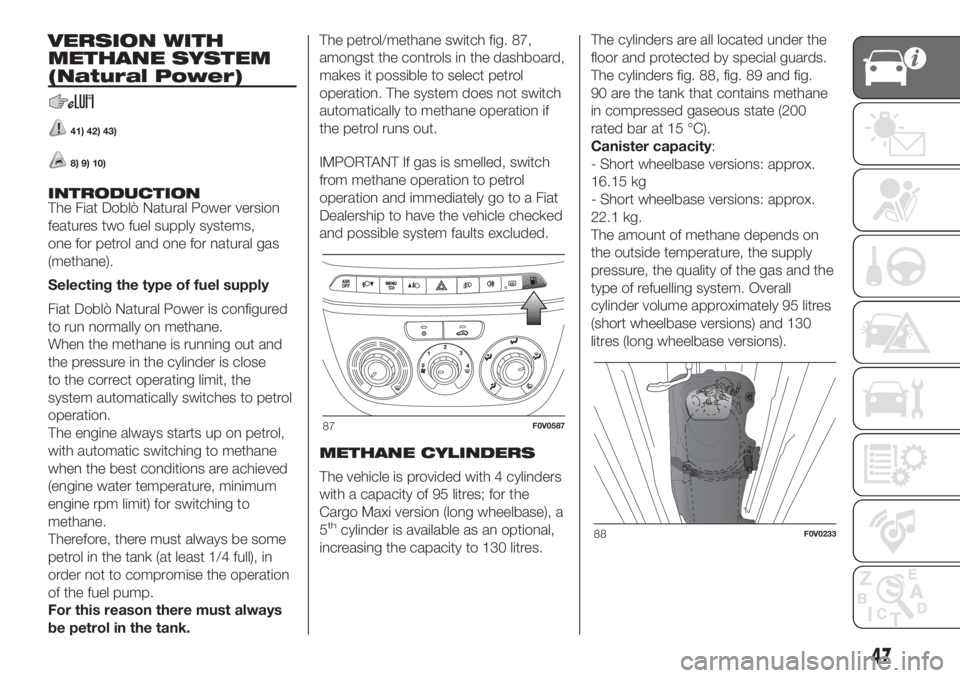
VERSION WITH
METHANE SYSTEM
(Natural Power)
41) 42) 43)
8) 9) 10)
INTRODUCTION
The Fiat Doblò Natural Power version
features two fuel supply systems,
one for petrol and one for natural gas
(methane).
Selecting the type of fuel supply
Fiat Doblò Natural Power is configured
to run normally on methane.
When the methane is running out and
the pressure in the cylinder is close
to the correct operating limit, the
system automatically switches to petrol
operation.
The engine always starts up on petrol,
with automatic switching to methane
when the best conditions are achieved
(engine water temperature, minimum
engine rpm limit) for switching to
methane.
Therefore, there must always be some
petrol in the tank (at least 1/4 full), in
order not to compromise the operation
of the fuel pump.
For this reason there must always
be petrol in the tank.The petrol/methane switch fig. 87,
amongst the controls in the dashboard,
makes it possible to select petrol
operation. The system does not switch
automatically to methane operation if
the petrol runs out.
IMPORTANT If gas is smelled, switch
from methane operation to petrol
operation and immediately go to a Fiat
Dealership to have the vehicle checked
and possible system faults excluded.
METHANE CYLINDERS
The vehicle is provided with 4 cylinders
with a capacity of 95 litres; for the
Cargo Maxi version (long wheelbase), a
5
thcylinder is available as an optional,
increasing the capacity to 130 litres.The cylinders are all located under the
floor and protected by special guards.
The cylinders fig. 88, fig. 89 and fig.
90 are the tank that contains methane
in compressed gaseous state (200
rated bar at 15 °C).
Canister capacity:
- Short wheelbase versions: approx.
16.15 kg
- Short wheelbase versions: approx.
22.1 kg.
The amount of methane depends on
the outside temperature, the supply
pressure, the quality of the gas and the
type of refuelling system. Overall
cylinder volume approximately 95 litres
(short wheelbase versions) and 130
litres (long wheelbase versions).
87F0V0587
88F0V0233
47
Page 60 of 272
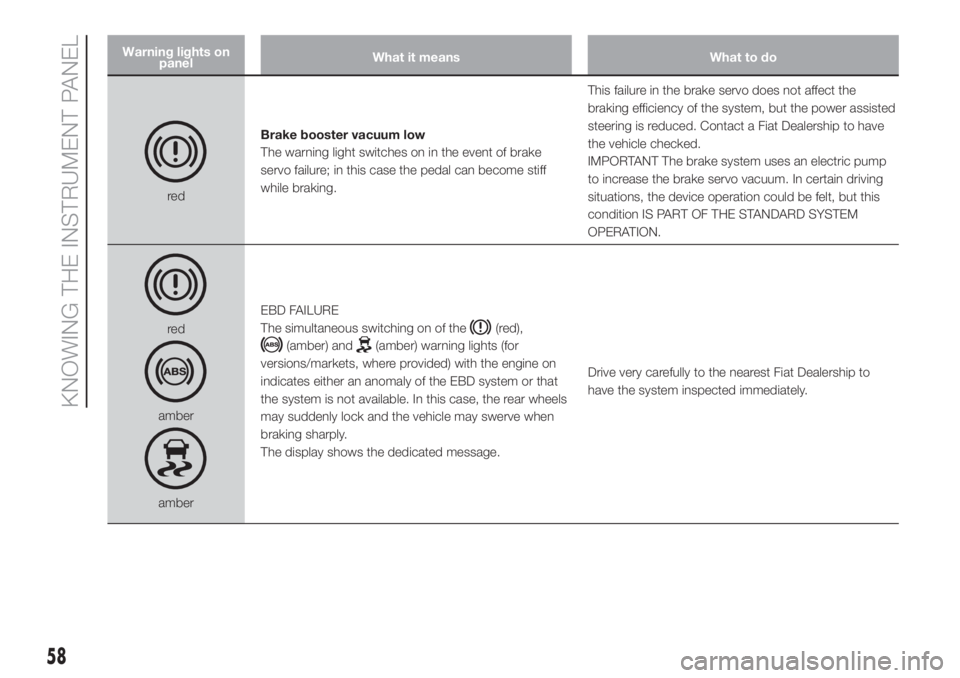
Warning lights on
panelWhat it means What to do
redBrake booster vacuum low
The warning light switches on in the event of brake
servo failure; in this case the pedal can become stiff
while braking.This failure in the brake servo does not affect the
braking efficiency of the system, but the power assisted
steering is reduced. Contact a Fiat Dealership to have
the vehicle checked.
IMPORTANT The brake system uses an electric pump
to increase the brake servo vacuum. In certain driving
situations, the device operation could be felt, but this
condition IS PART OF THE STANDARD SYSTEM
OPERATION.
red
amber
amberEBD FAILURE
The simultaneous switching on of the
(red),
(amber) and(amber) warning lights (for
versions/markets, where provided) with the engine on
indicates either an anomaly of the EBD system or that
the system is not available. In this case, the rear wheels
may suddenly lock and the vehicle may swerve when
braking sharply.
The display shows the dedicated message.Drive very carefully to the nearest Fiat Dealership to
have the system inspected immediately.
58
KNOWING THE INSTRUMENT PANEL
Page 75 of 272

Warning lights on
panelWhat it means What to do
greenLEFT DIRECTION INDICATOR
The warning light switches on when the direction
indicator control stalk is moved downwards or, together
with the right direction indicator, when the hazard
warning light button is pressed.
greenRIGHT DIRECTION INDICATOR
The warning light switches on when the direction
indicator control stalk is moved upwards or, together
with the left direction indicator, when the hazard warning
light button is pressed.
greenFOG LIGHTS
The warning light comes on when the front fog lights are
turned on.
greenCRUISE CONTROL
(for versions/markets, where provided)
The digital warning light switches on in the display when
the ignition key is turned to MAR, but it should switch
off after a few seconds, if the Cruise Control is
deactivated.
The warning light is lit up on the display by turning the
Cruise Control selector wheel to ON or, according
to the versions. On certain versions a dedicated
message is displayed.
73
Page 79 of 272

ACTIVE SAFETY
SYSTEMS
The vehicle has the following active
safety systems:
ABS;
EBD system;
Brake Assist system;
ESC system;
ASR system;
Hill Holder system;
MSR system;
For the operation of the systems, see
the following pages.
ABS SYSTEM
This is an integral part of the braking
system, which prevents one or more
wheels from locking and slipping
regardless of the road surface
conditions and braking intensity,
ensuring control of the vehicle even
during emergency braking.
The Electronic Braking Force
Distribution (EBD) system completes
the system allowing the brake force to
be distributed between the front and
rear wheels.
IMPORTANT To get the maximum
efficiency of the braking system,
a bedding-in period of about 500 km is
needed: during this period it is better
to avoid sharp, repeated and prolonged
braking.
SYSTEM INTERVENTION
The driver can feel that the ABS has
come into action because the brake
pedal pulsates slightly and the system
gets noisier: it means that the vehicle
speed should be altered to suit the type
of road surface.
50) 51) 52)
FAULT INDICATIONS
ABS fault
ABS failure is indicated by the
warning light on the instrument
panel coming on (together with the
appropriate message on the
multifunction display on some versions)
(see “Warning lights and messages”).
In this case, the braking system will still
be effective, although without the
extra capacity offered by the ABS.
Drive carefully to the nearest Fiat
Dealership to have the system
checked.
EBD failure
ABS failure is indicated by the
and
warning lights on the instrument
panel coming on (together with the
appropriate message on the
multifunction display on some versions)
(see “Warning lights and messages”).
In this case, the rear wheels may
suddenly lock and the vehicle may
swerve when braking sharply. Drive
carefully to the nearest Fiat Dealership
to have the system checked.
53)
77
Page 80 of 272
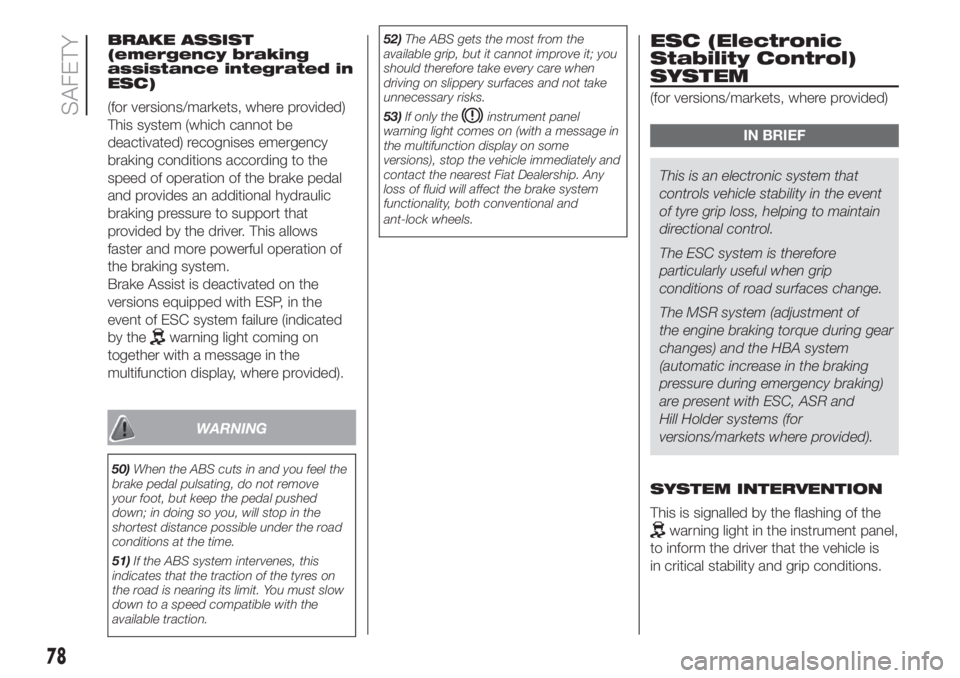
BRAKE ASSIST
(emergency braking
assistance integrated in
ESC)
(for versions/markets, where provided)
This system (which cannot be
deactivated) recognises emergency
braking conditions according to the
speed of operation of the brake pedal
and provides an additional hydraulic
braking pressure to support that
provided by the driver. This allows
faster and more powerful operation of
the braking system.
Brake Assist is deactivated on the
versions equipped with ESP, in the
event of ESC system failure (indicated
by the
warning light coming on
together with a message in the
multifunction display, where provided).
WARNING
50)When the ABS cuts in and you feel the
brake pedal pulsating, do not remove
your foot, but keep the pedal pushed
down; in doing so you, will stop in the
shortest distance possible under the road
conditions at the time.
51)If the ABS system intervenes, this
indicates that the traction of the tyres on
the road is nearing its limit. You must slow
down to a speed compatible with the
available traction.52)The ABS gets the most from the
available grip, but it cannot improve it; you
should therefore take every care when
driving on slippery surfaces and not take
unnecessary risks.
53)If only the
instrument panel
warning light comes on (with a message in
the multifunction display on some
versions), stop the vehicle immediately and
contact the nearest Fiat Dealership. Any
loss of fluid will affect the brake system
functionality, both conventional and
ant-lock wheels.
ESC (Electronic
Stability Control)
SYSTEM
(for versions/markets, where provided)
IN BRIEF
This is an electronic system that
controls vehicle stability in the event
of tyre grip loss, helping to maintain
directional control.
The ESC system is therefore
particularly useful when grip
conditions of road surfaces change.
The MSR system (adjustment of
the engine braking torque during gear
changes) and the HBA system
(automatic increase in the braking
pressure during emergency braking)
are present with ESC, ASR and
Hill Holder systems (for
versions/markets where provided).
SYSTEM INTERVENTION
This is signalled by the flashing of the
warning light in the instrument panel,
to inform the driver that the vehicle is
in critical stability and grip conditions.
78
SAFETY
Page 81 of 272
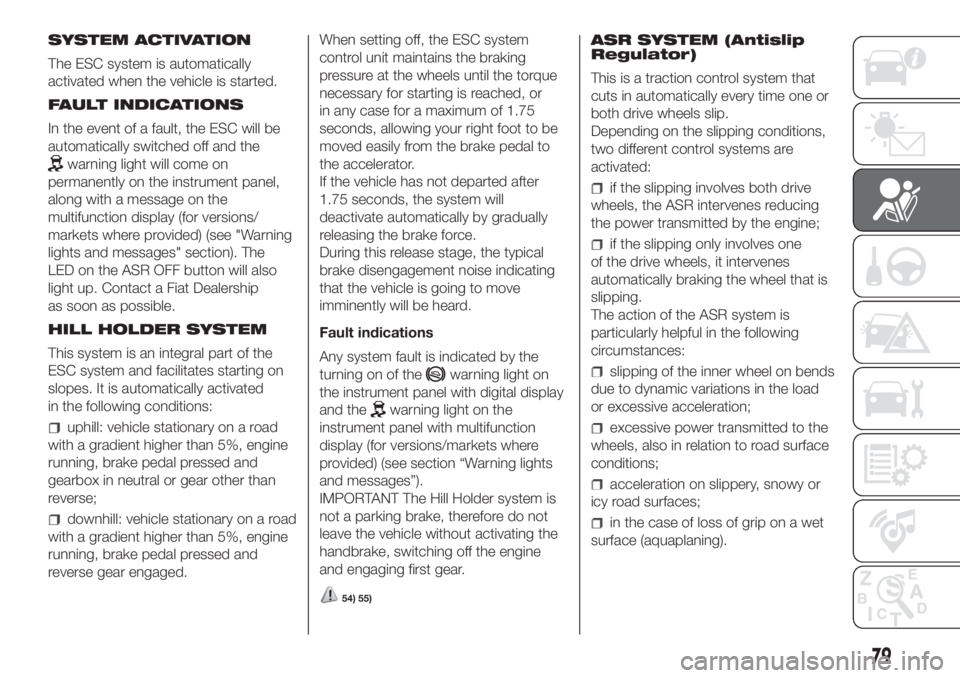
SYSTEM ACTIVATION
The ESC system is automatically
activated when the vehicle is started.
FAULT INDICATIONS
In the event of a fault, the ESC will be
automatically switched off and the
warning light will come on
permanently on the instrument panel,
along with a message on the
multifunction display (for versions/
markets where provided) (see "Warning
lights and messages" section). The
LED on the ASR OFF button will also
light up. Contact a Fiat Dealership
as soon as possible.
HILL HOLDER SYSTEM
This system is an integral part of the
ESC system and facilitates starting on
slopes. It is automatically activated
in the following conditions:
uphill: vehicle stationary on a road
with a gradient higher than 5%, engine
running, brake pedal pressed and
gearbox in neutral or gear other than
reverse;
downhill: vehicle stationary on a road
with a gradient higher than 5%, engine
running, brake pedal pressed and
reverse gear engaged.When setting off, the ESC system
control unit maintains the braking
pressure at the wheels until the torque
necessary for starting is reached, or
in any case for a maximum of 1.75
seconds, allowing your right foot to be
moved easily from the brake pedal to
the accelerator.
If the vehicle has not departed after
1.75 seconds, the system will
deactivate automatically by gradually
releasing the brake force.
During this release stage, the typical
brake disengagement noise indicating
that the vehicle is going to move
imminently will be heard.
Fault indications
Any system fault is indicated by the
turning on of the
warning light on
the instrument panel with digital display
and the
warning light on the
instrument panel with multifunction
display (for versions/markets where
provided) (see section “Warning lights
and messages”).
IMPORTANT The Hill Holder system is
not a parking brake, therefore do not
leave the vehicle without activating the
handbrake, switching off the engine
and engaging first gear.
54) 55)
ASR SYSTEM (Antislip
Regulator)
This is a traction control system that
cuts in automatically every time one or
both drive wheels slip.
Depending on the slipping conditions,
two different control systems are
activated:
if the slipping involves both drive
wheels, the ASR intervenes reducing
the power transmitted by the engine;
if the slipping only involves one
of the drive wheels, it intervenes
automatically braking the wheel that is
slipping.
The action of the ASR system is
particularly helpful in the following
circumstances:
slipping of the inner wheel on bends
due to dynamic variations in the load
or excessive acceleration;
excessive power transmitted to the
wheels, also in relation to road surface
conditions;
acceleration on slippery, snowy or
icy road surfaces;
in the case of loss of grip on a wet
surface (aquaplaning).
79
Page 82 of 272
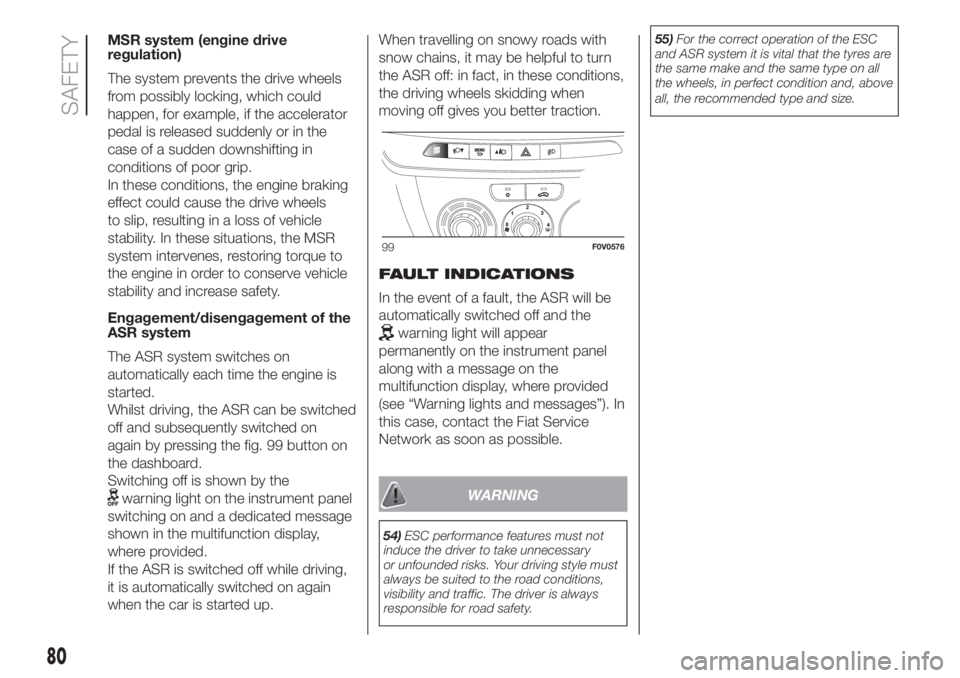
MSR system (engine drive
regulation)
The system prevents the drive wheels
from possibly locking, which could
happen, for example, if the accelerator
pedal is released suddenly or in the
case of a sudden downshifting in
conditions of poor grip.
In these conditions, the engine braking
effect could cause the drive wheels
to slip, resulting in a loss of vehicle
stability. In these situations, the MSR
system intervenes, restoring torque to
the engine in order to conserve vehicle
stability and increase safety.
Engagement/disengagement of the
ASR system
The ASR system switches on
automatically each time the engine is
started.
Whilst driving, the ASR can be switched
off and subsequently switched on
again by pressing the fig. 99 button on
the dashboard.
Switching off is shown by the
warning light on the instrument panel
switching on and a dedicated message
shown in the multifunction display,
where provided.
If the ASR is switched off while driving,
it is automatically switched on again
when the car is started up.When travelling on snowy roads with
snow chains, it may be helpful to turn
the ASR off: in fact, in these conditions,
the driving wheels skidding when
moving off gives you better traction.
FAULT INDICATIONS
In the event of a fault, the ASR will be
automatically switched off and the
warning light will appear
permanently on the instrument panel
along with a message on the
multifunction display, where provided
(see “Warning lights and messages”). In
this case, contact the Fiat Service
Network as soon as possible.
WARNING
54)ESC performance features must not
induce the driver to take unnecessary
or unfounded risks. Your driving style must
always be suited to the road conditions,
visibility and traffic. The driver is always
responsible for road safety.55)For the correct operation of the ESC
and ASR system it is vital that the tyres are
the same make and the same type on all
the wheels, in perfect condition and, above
all, the recommended type and size.
99F0V0576
80
SAFETY
Page 86 of 272
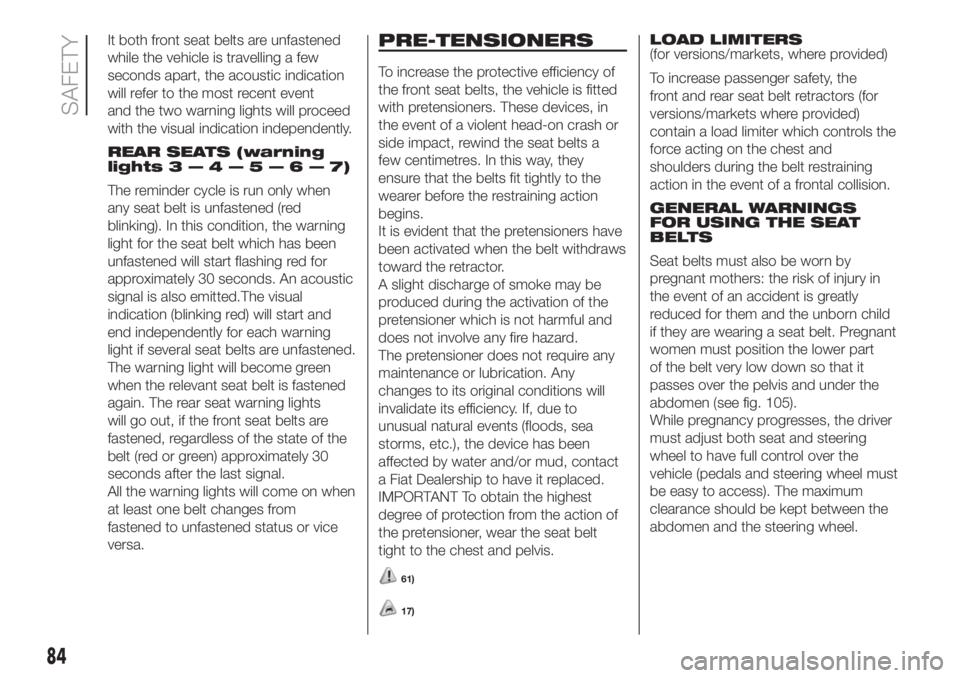
It both front seat belts are unfastened
while the vehicle is travelling a few
seconds apart, the acoustic indication
will refer to the most recent event
and the two warning lights will proceed
with the visual indication independently.
REAR SEATS (warning
lights3—4—5—6—7)
The reminder cycle is run only when
any seat belt is unfastened (red
blinking). In this condition, the warning
light for the seat belt which has been
unfastened will start flashing red for
approximately 30 seconds. An acoustic
signal is also emitted.The visual
indication (blinking red) will start and
end independently for each warning
light if several seat belts are unfastened.
The warning light will become green
when the relevant seat belt is fastened
again. The rear seat warning lights
will go out, if the front seat belts are
fastened, regardless of the state of the
belt (red or green) approximately 30
seconds after the last signal.
All the warning lights will come on when
at least one belt changes from
fastened to unfastened status or vice
versa.
84
SAFETY
PRE-TENSIONERS
To increase the protective efficiency of
the front seat belts, the vehicle is fitted
with pretensioners. These devices, in
the event of a violent head-on crash or
side impact, rewind the seat belts a
few centimetres. In this way, they
ensure that the belts fit tightly to the
wearer before the restraining action
begins.
It is evident that the pretensioners have
been activated when the belt withdraws
toward the retractor.
A slight discharge of smoke may be
produced during the activation of the
pretensioner which is not harmful and
does not involve any fire hazard.
The pretensioner does not require any
maintenance or lubrication. Any
changes to its original conditions will
invalidate its efficiency. If, due to
unusual natural events (floods, sea
storms, etc.), the device has been
affected by water and/or mud, contact
a Fiat Dealership to have it replaced.
IMPORTANT To obtain the highest
degree of protection from the action of
the pretensioner, wear the seat belt
tight to the chest and pelvis.
61)
17)
LOAD LIMITERS
(for versions/markets, where provided)
To increase passenger safety, the
front and rear seat belt retractors (for
versions/markets where provided)
contain a load limiter which controls the
force acting on the chest and
shoulders during the belt restraining
action in the event of a frontal collision.
GENERAL WARNINGS
FOR USING THE SEAT
BELTS
Seat belts must also be worn by
pregnant mothers: the risk of injury in
the event of an accident is greatly
reduced for them and the unborn child
if they are wearing a seat belt. Pregnant
women must position the lower part
of the belt very low down so that it
passes over the pelvis and under the
abdomen (see fig. 105).
While pregnancy progresses, the driver
must adjust both seat and steering
wheel to have full control over the
vehicle (pedals and steering wheel must
be easy to access). The maximum
clearance should be kept between the
abdomen and the steering wheel.
Page 98 of 272
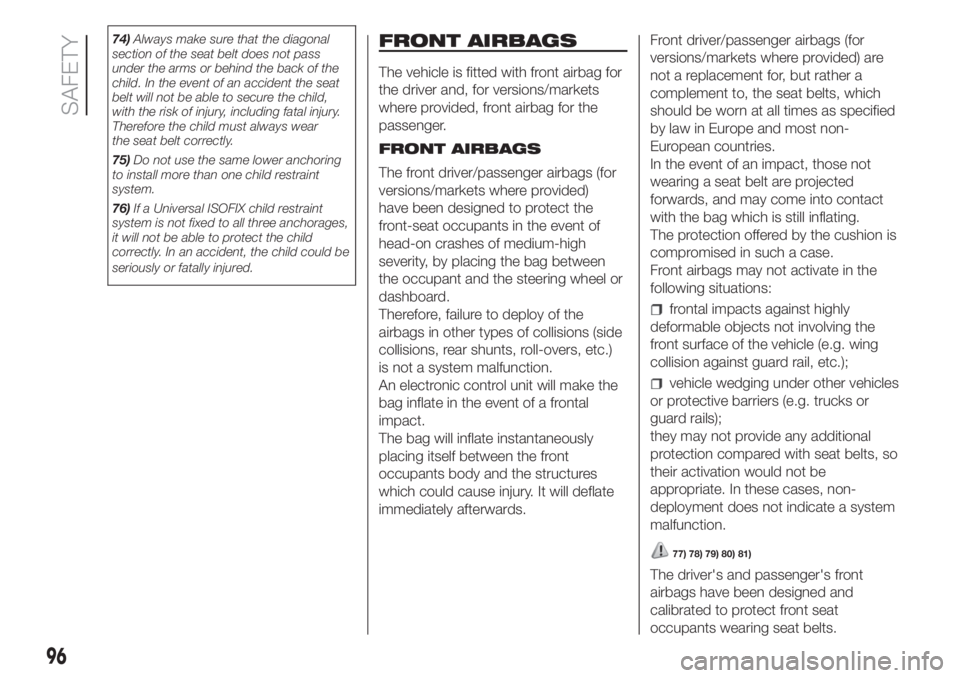
74)Always make sure that the diagonal
section of the seat belt does not pass
under the arms or behind the back of the
child. In the event of an accident the seat
belt will not be able to secure the child,
with the risk of injury, including fatal injury.
Therefore the child must always wear
the seat belt correctly.
75)Do not use the same lower anchoring
to install more than one child restraint
system.
76)If a Universal ISOFIX child restraint
system is not fixed to all three anchorages,
it will not be able to protect the child
correctly. In an accident, the child could be
seriously or fatally injured.FRONT AIRBAGS
The vehicle is fitted with front airbag for
the driver and, for versions/markets
where provided, front airbag for the
passenger.
FRONT AIRBAGS
The front driver/passenger airbags (for
versions/markets where provided)
have been designed to protect the
front-seat occupants in the event of
head-on crashes of medium-high
severity, by placing the bag between
the occupant and the steering wheel or
dashboard.
Therefore, failure to deploy of the
airbags in other types of collisions (side
collisions, rear shunts, roll-overs, etc.)
is not a system malfunction.
An electronic control unit will make the
bag inflate in the event of a frontal
impact.
The bag will inflate instantaneously
placing itself between the front
occupants body and the structures
which could cause injury. It will deflate
immediately afterwards.Front driver/passenger airbags (for
versions/markets where provided) are
not a replacement for, but rather a
complement to, the seat belts, which
should be worn at all times as specified
by law in Europe and most non-
European countries.
In the event of an impact, those not
wearing a seat belt are projected
forwards, and may come into contact
with the bag which is still inflating.
The protection offered by the cushion is
compromised in such a case.
Front airbags may not activate in the
following situations:
frontal impacts against highly
deformable objects not involving the
front surface of the vehicle (e.g. wing
collision against guard rail, etc.);
vehicle wedging under other vehicles
or protective barriers (e.g. trucks or
guard rails);
they may not provide any additional
protection compared with seat belts, so
their activation would not be
appropriate. In these cases, non-
deployment does not indicate a system
malfunction.
77) 78)
The driver's and passenger's front
airbags have been designed and
calibrated to protect front seat
occupants wearing seat belts.
96
SAFETY
79) 80) 81)
Page 99 of 272
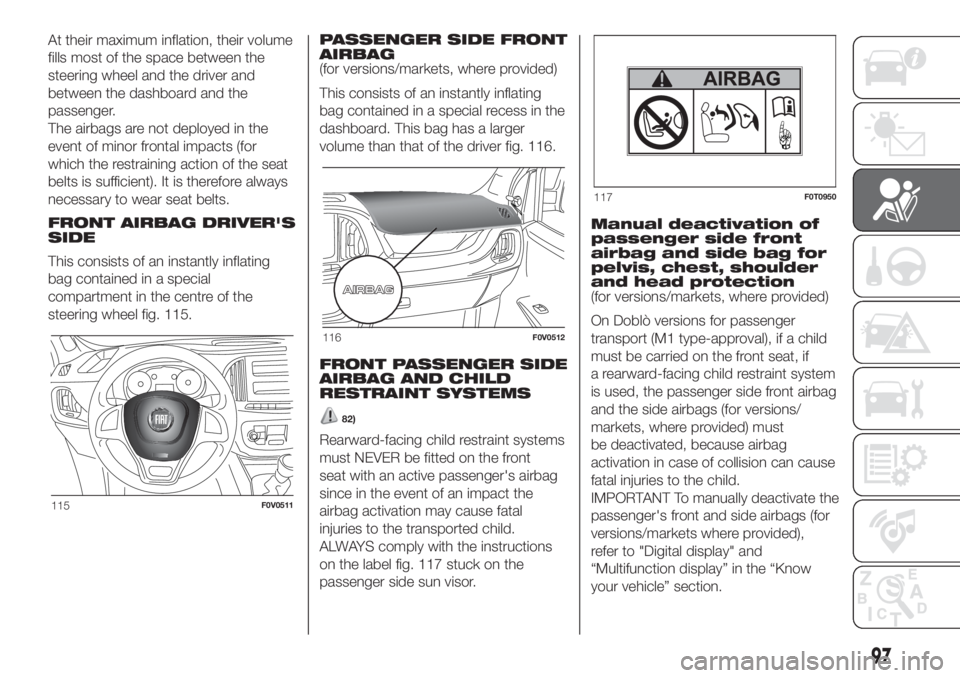
At their maximum inflation, their volume
fills most of the space between the
steering wheel and the driver and
between the dashboard and the
passenger.
The airbags are not deployed in the
event of minor frontal impacts (for
which the restraining action of the seat
belts is sufficient). It is therefore always
necessary to wear seat belts.
FRONT AIRBAG DRIVER'S
SIDE
This consists of an instantly inflating
bag contained in a special
compartment in the centre of the
steering wheel fig. 115.PASSENGER SIDE FRONT
AIRBAG
(for versions/markets, where provided)
This consists of an instantly inflating
bag contained in a special recess in the
dashboard. This bag has a larger
volume than that of the driver fig. 116.
FRONT PASSENGER SIDE
AIRBAG AND CHILD
RESTRAINT SYSTEMS
82)
Rearward-facing child restraint systems
must NEVER be fitted on the front
seat with an active passenger's airbag
since in the event of an impact the
airbag activation may cause fatal
injuries to the transported child.
ALWAYS comply with the instructions
on the label fig. 117 stuck on the
passenger side sun visor.Manual deactivation of
passenger side front
airbag and side bag for
pelvis, chest, shoulder
and head protection
(for versions/markets, where provided)
On Doblò versions for passenger
transport (M1 type-approval), if a child
must be carried on the front seat, if
a rearward-facing child restraint system
is used, the passenger side front airbag
and the side airbags (for versions/
markets, where provided) must
be deactivated, because airbag
activation in case of collision can cause
fatal injuries to the child.
IMPORTANT To manually deactivate the
passenger's front and side airbags (for
versions/markets where provided),
refer to "Digital display" and
“Multifunction display” in the “Know
your vehicle” section.
115F0V0511
116F0V0512
117F0T0950
97